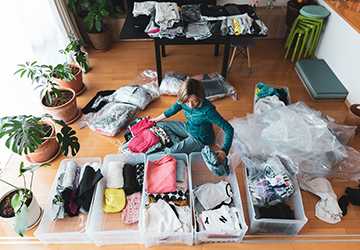Are you overwhelmed by the clutter in your home? A cluttered living space can affect mental well-being and productivity, leaving one very stressed and frustrated.
After a hard day, think about coming home to total peace and order, a place for everything, and the ability to find whatever you need.
That's the essence of decluttering!

Decluttering involves letting go of physical stuff, but it also decongestants your mind, making it easier to focus on what is important to you. It is liberating, and it can change everything.
This blog post presents the three most valuable ways of decluttering your home. Apply any one of these ways or each one individually, and then live with joy and inner peace.
The path to a clutter-free life begins now!
Decluttering is more of an investment in your mental and emotional well-being. A cluttered environment typically causes a lot of stress and anxiety. An untidy home makes one feel it's impossible to relax because the mind deals with much stuff. Intellectual cacophony might hinder any focus or productivity.
A clean and organized space encourages serenity. It will save a lot of time because everything is in its proper place and easy to find. Indeed, frustration is lessened in this kind of situation. Decluttering might seem like an arduous task, but in reality, it's pretty.
Let's consider three practical ways to help clear clutter from your home and bring a state of being free from clutter. Each paves the path, each in a unique way, toward simplicity and finding what fits you best.
This has become popularly known as the KonMari Method, after organization guru Marie Kondo's focus on keeping only what "sparks joy."
The drill first gathers every object of a specific category. In this case, say, clothes or books into one big pile. Pick it up and ask yourself, does this spark joy? If the answer is positive, keep it. If the answer is negative, thank the item for its service and let it go.
Then, categorize the remaining stuff and give each a home; this will help you pay attention and live with items you are content with.
The Four-Box Technique removes much of the mystery from clutter control by giving a clear, easy decision for every item.
Label four boxes: Keep, Donate, Trash, and Relocate. Go through each room and decide what box each item should be in; arranging everything reduces the chance of getting bogged down.

Items in the Keep box should have a place to live. Items in the Donate and Trash boxes deserve swift attention. The Relocate box is for cluttered things that should be elsewhere in your home.
This method helps you make speedy decisions and take action.
The Minimalist Approach involves reducing one's possessions to the basics. This method inspires one to know what one needs and discard all the unnecessary added stuff.
The first move should be picking out duplicates and dropping them. Always maintain possessions that have a utility value or high sentimental value. Avoid what is available; your investment pieces should be high quality and versatile.
Minimalism is adopting a continuous lifestyle. Review your belongings several times and know what you bring into your space.
A minimalist lifestyle can reduce stress, increase clarity, and help one appreciate what matters most.
Much more than just a trend, decluttering is a way to transform your life and, in turn, impact the quality of life. By following any of these methods discussed above, you'll be on the right path toward a much more peaceful and organized abode.
Discover sooner the improvement and the bliss of living in a decluttered home. Start decluttering now. Your future self will thank you for the newfound sense of calm, focus, and well-being that comes with a simplified space.
A decluttered home awaits you—embrace the change and enjoy the transformation.
Q. How often should I declutter my home?
Ans. This is a subjective issue based on the owners' needs and preferences. While some find seasonal decluttering useful, others prefer to have a deep clean once a year. Regularly assess and get rid of optional things.
Q. What should I do with things at home that I cannot decide whether to keep or throw out?
Ans. Keep a "maybe" box. Then, decide when to choose the next time you look into the box. If, by that time, you have not needed or missed a single item, it is safe to let the item go.
Q. How do I keep my home clutter-free once the clutter is decluttered?
Ans. To maintain balance, operate a "one in, one out policy." Consider chucking one thing for each new thing you bring into your house. Regularly assess your possessions and be very aware of what you allow into your space.